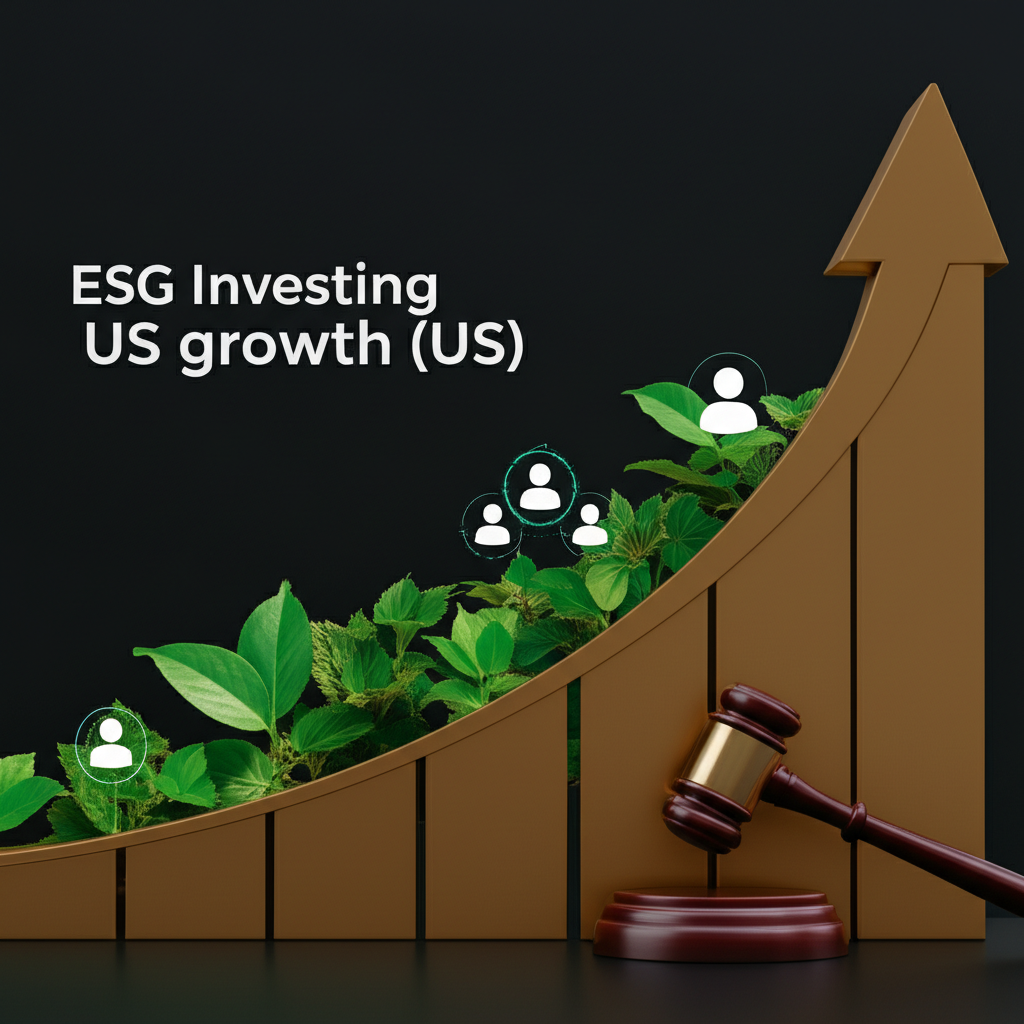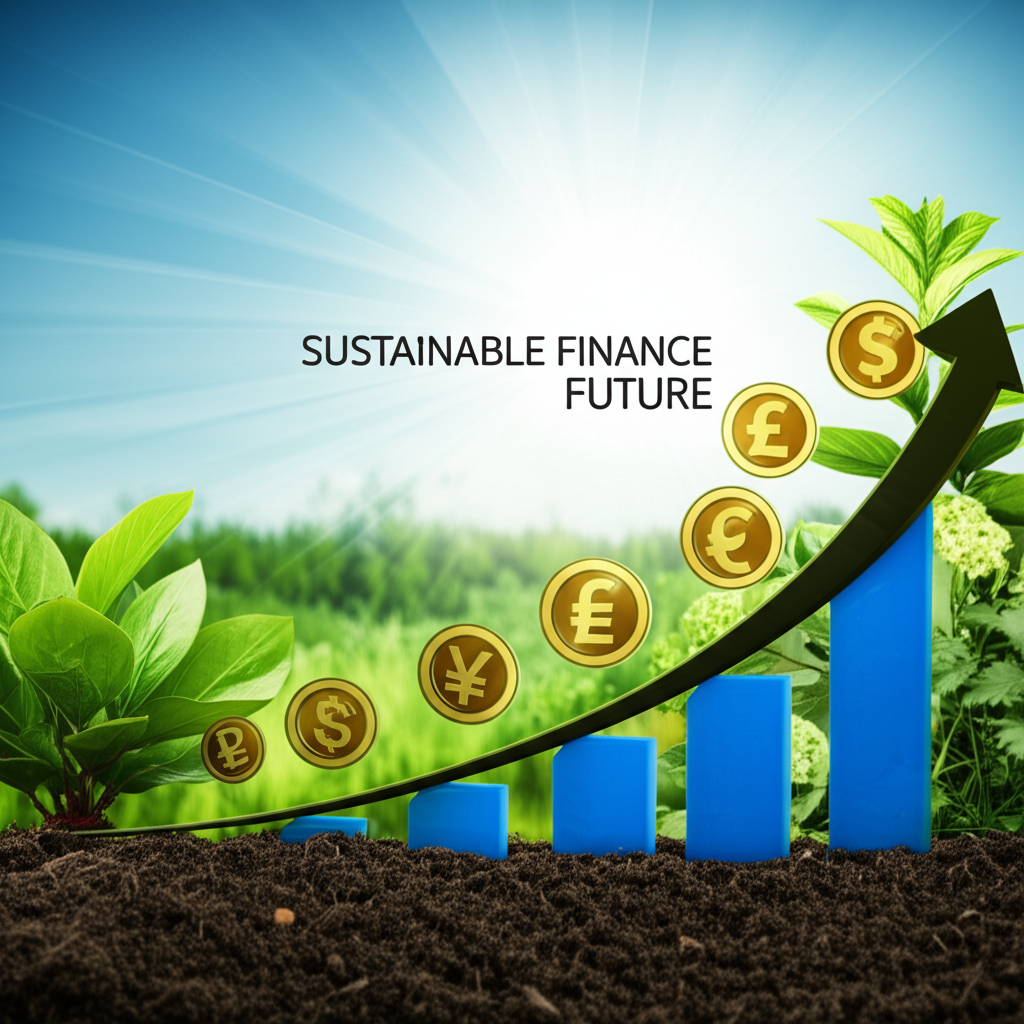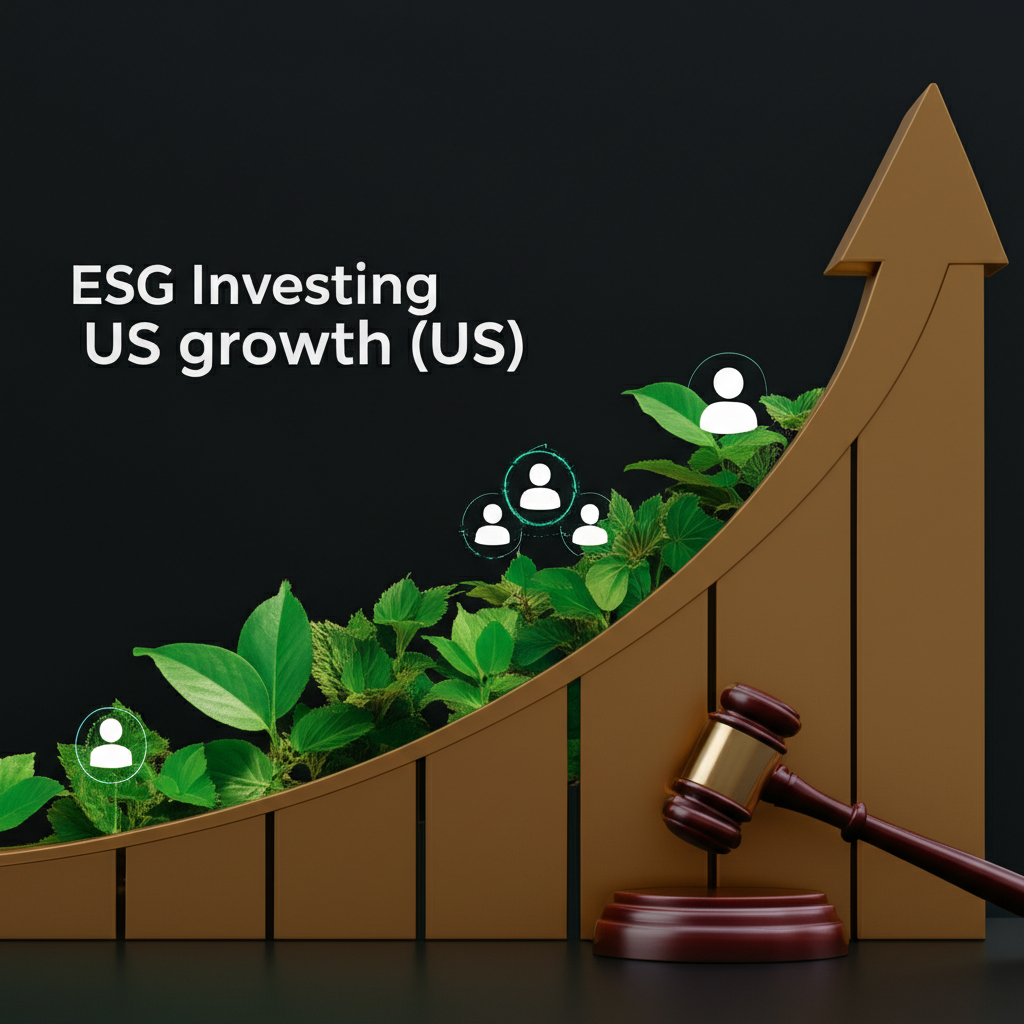Introduction: The Evolving Landscape of ESG Stocks Investing in the United States
ESG investing, which stands for environmental, social, and governance factors, has moved far beyond its early days as a specialized approach and now forms a key part of everyday finance. In the United States, this change stands out clearly, with everyday investors, financial planners, and big institutions all seeing how sustainable business practices tie directly into lasting financial success. Heading into 2025, ESG stock opportunities in the US look set to transform further, shaped by new rules from regulators, cutting-edge tech developments, and a growing awareness among people putting their money to work. This guide offers US investors practical, forward-thinking advice on the trends, hurdles, and openings ahead, along with steps to weave ESG ideas into investment plans. At its core, this isn’t only about doing good-it’s a savvy way to build wealth that holds up in our linked global economy.

From rising interest in clean energy to demands for fairer workplaces, the forces at play reflect broader societal priorities. For instance, recent surveys show that over 80% of US investors now consider ESG elements when choosing where to invest, up sharply from just a few years ago. By staying ahead of these shifts, investors can position themselves to benefit from companies that not only survive but thrive amid environmental pressures and social changes.

What is ESG Investing? A Foundation for US Investors
ESG investing goes by names like sustainable or responsible investing, and it means looking at companies through lenses beyond just the numbers on their balance sheets. It weighs how they handle non-financial issues alongside their profits and growth. For investors in the US, getting a solid handle on these basics helps line up choices with personal beliefs and money goals alike.
Environmental Factors (E)
These elements look at how a business affects the planet. In the US context, they cover efforts to fight climate change, cut down on carbon output, and switch to renewables like solar and wind power. People investing check on things like how the company uses resources such as water and land, steps to avoid pollution, handling waste, and its total mark on the environment. With the US facing more extreme weather and policy pushes for green shifts, firms leading here often prove tougher against shocks and more innovative overall.
Social Factors (S)
Social aspects explore ties between a company and its people-workers, buyers, partners, and local areas. For US businesses, this includes fair pay and safe jobs, programs for diversity, equity, and inclusion, respect for human rights, protecting customer info, safe products, and giving back to communities. Solid results in these areas build trust in the brand, draw in skilled staff, and cut down on problems like lawsuits or boycotts.
Governance Factors (G)
Governance covers how a company is run, with checks inside and rights for those who own shares. It’s all about keeping things honest and open. US investors dig into board makeup and freedom from conflicts, how bosses get paid, ethical standards, rules against corruption, owner voting power, and solid audits. Strong setups like these support smart choices and block scandals, protecting those investing their hard-earned cash.
Why does ESG drive lasting value in the US? Weaving these factors into how you pick investments spots firms ready to handle threats and grab chances tied to green practices. It builds tougher holdings that might beat the market over time while doing good for people and the planet. Take the rise of companies like those in tech that prioritize data privacy- they’ve often seen loyalty from customers translate to steady revenue.
| ESG Factor | Core Focus | US Market Relevance & Examples |
|---|---|---|
| Environmental (E) | Impact on natural systems | Climate Change: Carbon footprint, renewable energy adoption (e.g., solar, wind farms). Resource Management: Water conservation in agriculture, sustainable packaging. |
| Social (S) | Relationships with stakeholders | Labor Practices: Fair wages, union relations, employee safety. Diversity & Inclusion: Board and workforce diversity initiatives. Community Impact: Philanthropy, local job creation. |
| Governance (G) | Company leadership & structure | Board Composition: Independent directors, gender diversity. Executive Pay: Alignment with performance, shareholder approval. Ethics: Anti-bribery policies, whistleblower protections. |
Major ESG Stocks Investing Trends to Watch in the United States for 2025
With 2025 on the horizon, a handful of big-picture shifts will guide ESG choices in the US, affecting how businesses operate and where smart money flows.
Climate Transition and Net-Zero Commitments
Climate pressures aren’t letting up, pushing more cash into solutions. US firms now face expectations to report emissions openly and map out real plans to hit net-zero. This boosts funding for clean power like solar panels, wind turbines, and better batteries, while nudging heavy industries toward cleaner ways. Investors will favor companies showing real steps toward handling climate hits and cutting carbon, such as automakers rolling out electric fleets faster than rivals.
Social Equity and Stakeholder Capitalism
Social issues are heating up after years of cultural changes. US companies must step up on diversity, equity, and inclusion from top executives to shop-floor teams. Fair treatment, good pay, and support for worker health will set leaders apart. Stakeholder capitalism-balancing owners with everyone else involved-is catching on, steering investments toward firms that build community ties and clean supply lines, like apparel brands auditing overseas factories rigorously.
Enhanced Corporate Governance and Transparency
Governance stays front and center, with closer looks at independent boards, pay tied to ESG aims, and ethical conduct. In the US, clear reporting will go beyond dollars to cover green effects, social work, and leadership setups fully. Activist shareholders will push harder on these, urging stronger, more open management that builds trust and cuts fraud risks.
Growth of Green Bonds and Sustainable Finance Products
Sustainable options will keep growing in the US. Green bonds, which bankroll eco-projects, join social and linked bonds in popularity. ESG ETFs and funds will multiply, giving investors easy ways to spread bets across themes like clean tech or fair labor, fitting different levels of risk and interests. This makes it simpler for anyone from retirees to pros to join the green wave without picking single stocks.
US Regulatory Environment and Policy Shifts Impacting ESG Stocks in 2025
Rules in the United States keep changing, steering ESG paths for companies and those watching their moves. By 2025, expect sharper guidelines that demand more from public firms and sharper eyes from investors.
SEC Disclosure Requirements
The Securities and Exchange Commission is pushing rules on climate dangers and workforce details. Come 2025, US public companies might need to share standard info on emissions, climate money risks, and human resources like diversity stats and staff churn. This helps investors compare apples to apples. The SEC’s ongoing efforts point to a push for real accountability in how sustainability gets reported.
State-Level Initiatives and Influence
Federal moves aside, states are stepping in big time on ESG. Some pass laws for more renewables or diverse boards, while others resist, worrying about duties to savers or politics. This mix makes things tricky for nationwide plays, so investors and execs must track local rules. For example, California’s strict climate mandates contrast with energy-state pushback, creating chances in green tech on one coast and traditional energy tweaks on the other.
Anti-ESG Sentiment and Its Counter-Response
Pushback against ESG is real in parts of the US, with some calling it overreach or against pure profit focus. Laws in certain states limit its use in pensions or funds. Yet, many investors and firms fight back, viewing ESG as key to dodging risks and building value. In 2025, the key will be cutting through noise to focus on hard data, like emission cuts or diversity hires, rather than headlines.
These forces mean companies must back up ESG talk with proof, and investors should double-check reports against national and local rules to spot fakes and stay legal.
Leveraging Technology: AI and Data Analytics in ESG Investing for US Markets
Tech is supercharging ESG in the US, especially with AI and data crunching changing how info gets gathered and used for picks.
AI and machine learning shine in pulling ESG details from messy sources like reports, news, tweets, and even satellite photos. This beats old-school reading, spotting things like worker strikes or spills quickly. For US investors, it means deeper looks at a firm’s true ESG story, beyond polished summaries.
Big data uncovers hidden patterns, like early supply snags or buyer shifts to green goods, or rule changes hitting industries. In the US, this foresight helps tweak holdings before trouble hits, such as foreseeing water rules affecting farms in the Midwest.
Tech fights fakers too, by matching claims to real numbers, media buzz, and rivals. It calls out mismatches, helping US folks pick true leaders over posers and boosting overall trust.
Still, hurdles like uneven data rules and spotty quality persist in the US. No one standard means tough compares, and data floods can hide errors. Fixing this needs teamwork from watchdogs, info firms, and businesses to build better systems.
Sector-Specific ESG Opportunities and Risks in the United States (2025 Outlook)
ESG hits different across US industries, so knowing the nuances points to smart bets and dodge-able pitfalls for 2025.
Renewable Energy and Sustainable Technology
This area’s buzzing with ESG appeal in the US, driven by clean energy goals and self-reliance. Solar, wind, geothermal, hydro outfits, plus battery makers, grid upgraders, and EV chargers, all look strong. Seek firms with fresh ideas, growth potential, and government boosts, like those landing federal grants for offshore wind.
Healthcare and Biotech
In health, ESG eyes drug costs, fair access, moral trials, data security, and even care spread. Biotech gets grilled on gene tech ethics and broad benefits. Chances shine for affordable meds, equity pushes, and clean R&D, especially with US debates over coverage heating up.
Financial Services
Banks and managers in the US lead sustainable money flows, baking ESG into loans, picks, and insurance. Look to those crafting green loans, funding clean projects, and checking climate risks. Their own boards and teams face reviews too, rewarding diverse, ethical players.
Agriculture and Food Systems
Here, ESG tackles land strain, water woes, chemicals, waste, and tough chains. US leaders in eco-farming, plant-based eats, tower grows, smart tools, and clean sourcing draw eyes. Watch climate hits on harvests and security, with winners adapting via drought-proof seeds or local sourcing.
How US Investors Can Integrate ESG Stocks into Their Portfolios by 2025
US folks wanting values-matched money need a clear plan to add ESG stocks. 2025 brings better tools for this.
ESG Screening and Research Tools
Start with screeners like MSCI, Sustainalytics, or Bloomberg ESG for US firm scores. They let you pick high-flyers or skip bad actors in arms or coal. Match tools to your hot buttons, like climate over labor, and learn their scoring to pick wisely.
ESG Funds and ETFs
Funds and ETFs make ESG easy and spread-out for US investors, bundling qualifying companies to cut single-stock wobbles. From wide indexes to niche like women-led firms, check the details in prospectuses to confirm real ESG focus, not just labels.
Direct Stock Selection
Seasoned pickers can choose singles after deep dives into impacts, policies, and runs. Go past scores to ops, green breakthroughs, and staying power-read reports, vote on proposals, gauge openness. Top US ESG names often hail from tech or consumer goods with proven tracks.
For balance, mix ESG into overall plans, weighing how it tweaks risks. Review often as markets and firms shift, blending returns with real change.
Addressing Challenges: Greenwashing and Performance Concerns in US ESG Investing
ESG’s rise in the US comes with bumps, like false claims and return questions, that demand careful steps.
Identifying and Avoiding Greenwashing
Greenwashing tricks with hype over facts, like fuzzy words or spotlighting tiny efforts amid big problems. Watch for no-proof claims or past fines. Beat it with third-party scores, full reports over ads, and action checks. The Financial Times has extensively covered the growing scrutiny on greenwashing, stressing how it erodes faith.
ESG Performance Debate
Does ESG pay off? Studies say yes for long-haul, risk-tuned gains, thanks to smarter risks, green savings, rep boosts, and wider appeal. Short term? It dips with markets or sectors. See it as marathon play, not quick win, with evidence from funds outpacing in down times.
Lean on varied independent ratings for fair views, blending sources to cut biases and self-serve flaws, guiding solid US choices.
Conclusion: The Future of Responsible Investing in the United States
Looking to 2025 and further, ESG investing anchors US finance deeply. Shifts in climate action, fairness, rules, and tech redefine worth and growth. For US investors, it’s essential for risk smarts, spotting enduring wins, and aiding a fairer, greener world. Hurdles like hype and return talks linger, but deep checks, tech aids, and rule watches equip folks to succeed. Responsible US investing glows ahead, blending profits with purpose.
What are the top ESG investing trends for 2025 in the United States?
In 2025, key ESG investing trends in the US include a heightened focus on climate transition and net-zero commitments, increased emphasis on social equity and stakeholder capitalism, enhanced corporate governance and transparency, and continued growth in sustainable finance products like green bonds and ESG funds.
How do I find the best ESG stocks for my portfolio in the US?
To find the best ESG stocks in the US, utilize independent ESG screening and research tools that provide ratings and data. Consider investing in ESG-focused mutual funds or ETFs for diversified exposure, or conduct thorough direct stock selection by analyzing company sustainability reports and operational practices.
What is the future outlook for ESG investing in the United States?
The future outlook for ESG investing in the United States is strong and expanding. Driven by increasing investor demand, evolving regulatory frameworks (like potential SEC disclosures), and technological advancements in data analysis, ESG principles are becoming more deeply integrated into mainstream investment strategies, promising long-term growth and impact.
Are ESG stocks profitable in 2025?
Many studies suggest that companies with strong ESG practices can achieve comparable or even superior risk-adjusted returns over the long term compared to traditional investments. While short-term performance can fluctuate, the emphasis on good governance, risk management, and sustainable operations positions ESG stocks for resilience and potential profitability in 2025 and beyond.
What are the challenges of ESG investing in the US?
Key challenges for ESG investing in the US include greenwashing (misleading sustainability claims), a lack of universal data standardization, varying ESG rating methodologies, and ongoing political “anti-ESG” sentiment in some regions. Investors must conduct thorough due diligence and rely on credible data sources to navigate these complexities.
How can US investors identify truly sustainable companies?
US investors can identify truly sustainable companies by looking beyond marketing. Scrutinize independent ESG ratings from reputable providers, review comprehensive sustainability reports (e.g., GRI Standards), analyze a company’s operational impact, verify concrete targets (like net-zero commitments), and assess their track record on environmental, social, and governance issues.
What are the top 100 ESG companies in the United States?
Identifying a definitive “top 100” list can vary based on the specific ESG rating methodology and criteria used by different data providers (e.g., MSCI, Sustainalytics, S&P Global). Generally, leading ESG companies in the US tend to be those demonstrating strong performance across environmental impact reduction, robust social policies (like diversity and fair labor), and exemplary corporate governance. Investors should consult current reports from these rating agencies for updated lists.
Where can I find an ESG stocks list for 2025?
For an ESG stocks list relevant to 2025, you can refer to several resources. Financial data providers like Bloomberg, Refinitiv, and FactSet offer ESG data and screening tools. Investment research firms such as MSCI and Morningstar publish ESG ratings and analyses that can help identify top-performing companies. Additionally, many brokerage platforms and financial news outlets regularly update their lists of highly-rated ESG stocks and funds.



No responses yet